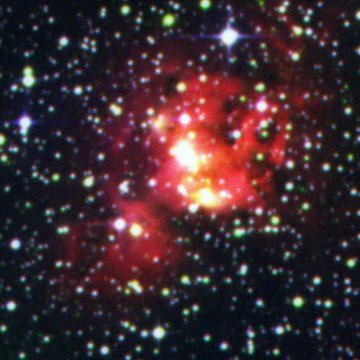RCW 99
Also called
Gum 50Coordinates: (328.57°, -0.53°)
[ Catalog | Explorer | SIMBAD ]
Avedisova lists 5 ionising stars, including the hot O5 III giant LSS 3443, the O9.5 II giant CP -53 6950 and 3 B-class supergiants. She places the nebula in star formation region SFR 328.60-0.51 along with the star cluster Trumpler 23.
The Georgelins give an O7 III class for LSS 3443 and SIMBAD lists it as a B-class star. A 2006 paper gives an age of 700 milion years and a distance of 2200 parsecs for Trumpler 23, raising some doubts as to whether this cluster can really be associated with RCW 99.
Dutra says that the infrared cluster [DBS2003] 98 is deeply embedded in RCW 99.
RCW 99 is an intensely bright infrared source as can be seen in this Spitzer image.
This is an extended HII region with low density and 102 solar masses.[2]
Dutra says that the infrared cluster [DBS2003] 98 is deeply embedded in RCW 99. [3]
Pinheiro et.al. claim in a 2010 paper that "No hot star towards [RCW 99] had been previously identified." and list O7 III and B2 V class ionising stars, [4] These appear to be identical to two of the ionising stars listed by Avedisova in 1984.
Notes
1. ^ Carraro, G., Janes, K. A., Costa, E., et al. (2006). "Photometry of seven overlooked open clusters in the first and fourth Galactic quadrants", Monthly Notices of the Royal Astronomical Society, Vol. 368, 1078-1086. [2006MNRAS.368.1078C]
2. ^ Braz, M. A., Jardim, J. O., & Kaufmann, P. (1975). "Characteristics of planetary nebulae and H II regions based on lambda equals 1.35 CM continuum measurements", Astronomy and Astrophysics, Vol. 43, 153-155. [1975A&A....43..153B]
3. ^ Dutra, C. M., Bica, E., Soares, J., et al. (2003). "New infrared star clusters in the southern Milky Way with 2MASS", Astronomy and Astrophysics, Vol. 400, 533-539. [2003A&A...400..533D]
4. ^ Pinheiro, M. C., Copetti, M. V. F., & Oliveira, V. A. (2010). "Spectral classification and distance determination of stars in nine southern Galactic H II regions", Astronomy and Astrophysics, Vol. 521, A26. [2010A&A...521A..26P]
Distance estimates
3000 pc [1994A&AS..108..513G]3500 pc [2003A&A...400..533D]
3500 pc +/- 500 [1989BAICz..40...42A]
3550 pc +/- 1820 [2010A&A...521A..26P]
Links
[ DSS | ADS | ADS Abstract ]
map | book | blog | gallery | sources

This image was created using the POSS-II/UKSTU data of the Digitized Sky Survey and SuperCOSMOS using the process described here.
According to my correspondence with the Royal Observatory Edinburgh and the Space Telescope Science Institute, I am allowed to use the POSS-II/UKSTU data to create and display images for non-commercial purposes so long as I include this fine print for the SuperCOSMOS data:
Use of these images is courtesy of the UK Schmidt Telescope (copyright in which is owned by the Particle Physics and Astronomy Research Council of the UK and the Anglo-Australian Telescope Board) and the Southern Sky Survey as created by the SuperCOSMOS measuring machine and are reproduced here with permission from the Royal Observatory Edinburgh.
and this acknowledgement taken from the DSS site:
The Digitized Sky Surveys were produced at the Space Telescope Science Institute under U.S. Government grant NAG W-2166. The images of these surveys are based on photographic data obtained using the Oschin Schmidt Telescope on Palomar Mountain and the UK Schmidt Telescope. The plates were processed into the present compressed digital form with the permission of these institutions.
The Second Palomar Observatory Sky Survey (POSS-II) was made by the California Institute of Technology with funds from the National Science Foundation, the National Geographic Society, the Sloan Foundation, the Samuel Oschin Foundation, and the Eastman Kodak Corporation.
The UK Schmidt Telescope was operated by the Royal Observatory Edinburgh, with funding from the UK Science and Engineering Research Council (later the UK Particle Physics and Astronomy Research Council), until 1988 June, and thereafter by the Anglo-Australian Observatory. The blue plates of the southern Sky Atlas and its Equatorial Extension (together known as the SERC-J), as well as the Equatorial Red (ER), and the Second Epoch [red] Survey (SES) were all taken with the UK Schmidt.
The "Second Epoch Survey" of the southern sky was made by the Anglo-Australian Observatory (AAO) with the UK Schmidt Telescope. Plates from this survey have been digitized and compressed by the ST ScI. The digitized images are copyright ? 1993-5 by the Anglo-Australian Observatory Board, and are distributed herein by agreement.
The "Equatorial Red Atlas" of the southern sky was made with the UK Schmidt Telescope. Plates from this survey have been digitized and compressed by the ST ScI. The digitized images are copyright ? 1992-5, jointly by the UK SERC/PPARC (Particle Physics and Astronomy Research Council, formerly Science and Engineering Research Council) and the Anglo-Australian Telescope Board, and are distributed herein by agreement.
The compressed files of the "Palomar Observatory - Space Telescope Science Institute Digital Sky Survey" of the northern sky, based on scans of the Second Palomar Sky Survey are copyright ? 1993-1995 by the California Institute of Technology and are distributed herein by agreement. The compressed files of the "Palomar Observatory - Space Telescope Science Institute Digital Sky Survey" of the northern sky, based on scans of the Second Palomar Sky Survey are copyright ? 1993-1995 by the California Institute of Technology and are distributed herein by agreement.